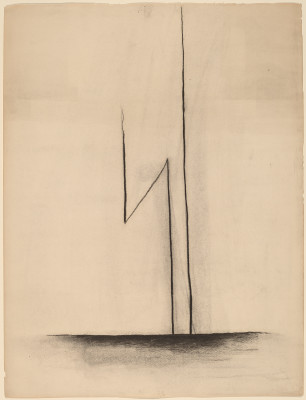In Light of Asia: Georgia O'Keeffe & Mark Rothko
In this final essay, Michael O'Neill looks at the influence of Buddhism and Zen on Western abstract and surreal artists.

Portrait photograph of Georgia O'Keeffe — by Alfred Stieglitz in 1918
In First Drawing of Blue Lines, we have an early work by Georgia O’Keeffe. Her teacher at art college, Arthur Dow, was heavily influenced by Eastern culture – and by Zen Buddhism in particular. If you didn’t know that this image was by O’Keeffe, you might think a Japanese artist had made it.

First Drawing of the Blue Lines (1916)
Dow said that he encouraged her to paint what was in her head, not what was out there in the world.

Georgia O’Keeffe outdoors with Pelvis Series Red With Yellow, 1960
CREDIT: GETTY IMAGES
O’Keeffe loved the desert storms of New Mexico. She explained that they evoked a specific state of mind for her; they were meditations. People often interpret her vibrant abstract lines in the sky as lightning, and although they might be, she wasn’t painting lightning as such: she was painting the feeling of awe and connection to Nature that was aroused in her. She said that these paintings always brought her back to that feeling. A lifelong favourite book of hers was The Secret of the Golden Flower, a Chinese Taoist text that contains an enquiry into the polar opposites of light and dark as well as describing esoteric Buddhist meditation techniques that develop “inner light”.
People always talk about O’Keeffe’s flower pictures, which are universally regarded as sexual imagery; yet that is very much how any post-Freudian art critic in the mid-twentieth century was going to appraise art. The flower pictures can also be seen as abstract art that simply happens to have concrete objects in it. It might be truer to say that O’Keeffe’s work abandoned any boundaries between representative and abstract art.
Although she was not explicitly Buddhist, she was clearly influenced by Buddhism, and, as noted, these works seem to be the product of meditative states.
There has been a broad Buddhist influence on modern art in general, and this has manifested as a lesser concern with painting the external world, and more of a focus on the subjective – the artist’s impressions – and a questioning of the process of creating a work of art. Zen, in particular, was taken up by many countercultural figures, and for many years it was by far the form of Buddhism best known in the West. Major influences include D. T. Suzuki’s series of lectures at Columbia University, and Eugen Herrigel’s book Zen in the Art of Archery. Our familiarity with Zen in the West has made us comfortable with works of art more explicitly influenced by Zen Buddhism.

Mark Rothko, Yorktown Heights, ca. 1949. Brooklyn Museum, by Consuelo Kanaga…
I have not been able to find anything written about Mark Rothko that mentions any Buddhist influences. Yet he produces works such as this:

No. 61 (Rust and Blue), 1953, 115 cm × 92 cm (45 in × 36 in). Museum of Contemporary Art, Los Angeles
Described as “Zen television” by one critic, Rothko’s paintings are very powerful, almost three-dimensional objects that, when seen in a gallery, arouse a sense of shock and awe. He said the following about his work:
I’m interested only in expressing basic human emotions – tragedy, ecstasy, doom and so on – and the fact that a lot of people break down and cry when confronted with my pictures show that I communicate those basic human emotions. The people who weep before my pictures are having the same religious experience I had when I painted them. And if you, as you say, are moved only by their colour relationships, then you miss the point!
What he’s talking about here is direct, heart-to-heart transmission, a central theme in Zen training and seen as the way to enlightenment by Mahayana Buddhists generally. Rothko really wanted us to engage with his creative process.
From our perspective, we can also apply Buddhist principles when looking at and appreciating art, and try to take a more meditative approach. When we go to galleries now, we often find something like the following scene, in which Leonardo da Vinci’s Mona Lisa is mobbed by tourists jostling for a view.

Museumgoers taking photographs of the Mona Lisa at the Louvre, Paris, 2012
Martin Parr/Magnum Photos
On any given day, when we enter the gallery, we only know that somewhere behind that crowd is the Mona Lisa. With art becoming increasingly commercial, it is now very hard to find a gallery where you can sit in peace and really look properly at a picture. I am reliably informed that in the Louvre, the average time people spend in front of a painting is ten seconds – and those are usually the great masterpieces of Western art. People just tend to walk past the rest.
If we want art to reach out to us, we need to reach out to art, and much of what Buddhism can be about is encouraging us to make ourselves open to receiving such things. Everything we do in life can be a transformative experience if we open up to it. Christmas Humphreys often wrote about Buddhism helping us to develop a sense of the wonderfulness of life, and taking it with us everywhere. Then, when you go to a gallery, you can allow yourself to stop for more than ten seconds and not think about why you like or don’t like a work of art; to consider the impact that work is having on you.
It’s important to remember that early artists such as Van Gogh and Monet instinctively saw things in Buddhist art before they even understood the concept of Buddhism; the artistic temperament picked up core concepts in Buddhism that are beyond words.
...
Text copyright to Michael O'Neill





